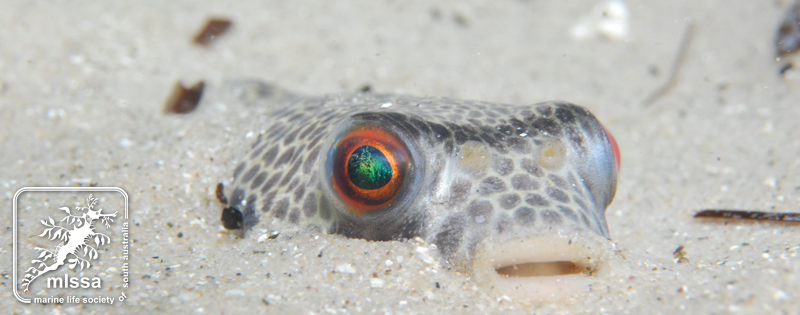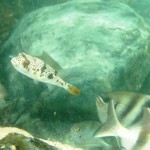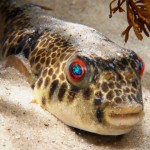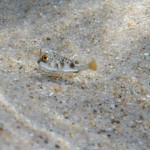Here’s why I rave about our toadies’ amazing eyes when seen via facemask in shallow, sandy, near-shore areas. I see them mainly late, in summer and autumn, when they are at their most prolific. They are found in very shallow areas almost anywhere in SA, except for the far west coast.
The image below which features their green and blue ‘opal’ eyes is from knee-depth shallows of Lady Bay on a bright sunny day. Despite the camera data stating ‘flash used: yes’, I assure you the image exactly mimics what I saw with my naked eyes in 100% ambient light. I have seen this effect often displayed by these very common ‘toadies’ (smooth toadfish Tetractenos glaber).
Indeed I’ve many dozens of similar shots of this adult individual and numerous other smooth toadies. Some are juveniles or sub-adults while most show equal, or maybe even better, opalescent appearance of the nearer pupil. The colour is always offset nicely by the red iris.
There are many fish species with lovely eyes, to be sure, but I find these local and much maligned toadies are as good as it gets with regard to mimicking opal. Meanwhile, they are often referred to by other Homo sapiens as ugly or slimy, are have to live with the facts that they are potentially toxic to touch and even lethal to eat!
A cursory, very incomplete search of my images of this species has returned only a minority featuring the red-rimmed opal eyes as the standout feature. Unsurprisingly though, many showcase some of the other guises under which this fish can appear to we snorkellers and divers. The shots have often been taken in low ambient light and with darker substrates, busier backgrounds, and with or without flash. Certain images show quite dark (deep indigo or black) pupils yet retain the lovely contrasting red eye rings.
There are two main pupillary colours and patterns displayed by Smooth toadfish eyes.
- Either rich opalescence with scintillating, highly reflective speckles and streaks
- or deep indigo to jet black non-reflective pupils
Within the confines of my limited search of my smooth toadfish image library, these appear at their most striking when the subject is well buried in sand, as per this article’s feature image. Further, this observation remains valid even when narrowing the image database to toadies part-buried only in very shallow, sandy, and brightly sunlit places.
So, what other variable may explain the fact that in some such shots the pupil is black but in others it’s either opalescent blue or opalescent blue/green?
I propose that the pupillary opalescence in some images taken in equally bright ambient light exists because these toadies are directing their gaze somewhat upwards (or downwards, in the case of a mid-water shot).
Conversely, if the angle of the fish’s gaze is essentially at or below horizontal (with no significant upwards gaze component) then the blue sky above will not be reflected or refracted via the pupils towards the viewer and camera lens. In the case of mixed emerald green and blue opalescence, both the blue sky above and the lush green seagrass which often bordering shallow sand patches may be reflected).
In cases where the photographer is gazing horizontally at the subject and the fish is returning the gaze, the fish’s pupils will appear black and non-reflective.






David recently photographed a smooth toadfish which was blind in one eye. We will post this online in another article on the subject.
[…] wrote an article titled “Opalescent Eye of Toadie – Reflecting on refracted light” – see https://mlssa.org.au/2014/08/11/opalescent-eye-of-toadie-reflecting-on-refracted-light […]